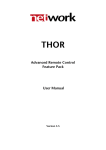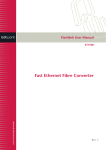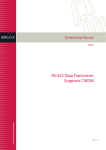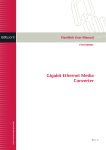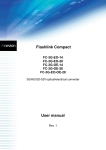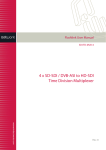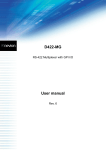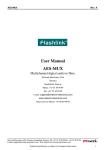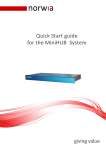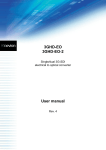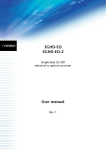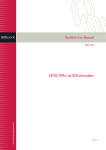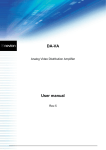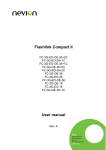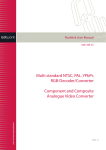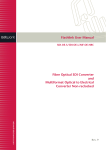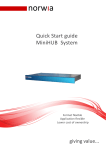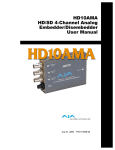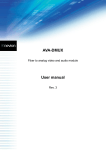Download AV-MUX
Transcript
Flashlink User Manual AV-MUX Digital Audio (De-)embedder network-electronics.com Rev. 9 AV-MUX Rev. 9 Network Electronics ASA Thorøya P.O. Box 1020 Sandefjord, Norway Phone: +47 33 48 99 99 Fax: +47 33 48 99 98 E-mail: [email protected] www.network-electronics.com Service Phone: +47 90 60 99 99 Revision history Current revision of this document is the uppermost in the table below. Revision Replaces Date 9 8 7 6 8 7 6 5 2007-10-23 2007-10-05 06/02/06 16/06/05 5 4 15/11/02 4 3 19/06/02 3 2 14/12/01 2 1 E D C B A 1 E D C B A 29/11/01 15/10/01 25/09/01 11/09/01 26/07/01 Change description New front page and removed old logo. Added Materials Declaration and EFUP Updated CWDM laser options. Added CWDM information. Block diagram. Improved configuration descriptions. DIP switch and Gyda figures. C2 backplane Change default. Disembedding now removes audio. DIP switch descriptions Power limitations, de-embed not disembed. Cascade Gyda command, Add-drop option. Re-corrected audio connections. Gyda interface. Corrected the audio connections More limitations. Preliminary version. Pre production run. 2 AV-MUX Rev. 9 Contents Revision history............................................................................... 2 1 Product overview......................................................................... 5 1.1 Signal flow...................................................................................................6 1.2 Product versions ..........................................................................................6 2 Specifications .............................................................................. 7 2.1 General........................................................................................................7 2.2 Video input..................................................................................................7 2.3 Audio inputs ................................................................................................7 2.4 SDI output...................................................................................................7 2.5 Audio outputs..............................................................................................8 2.6 Optical output.............................................................................................8 2.7 GPI output...................................................................................................8 3 Limitations................................................................................... 9 3.1 Power ..........................................................................................................9 3.2 Embedding..................................................................................................9 3.3 De-embedding ............................................................................................9 4 Configuration ............................................................................ 10 4.1 DIP switches ..............................................................................................10 4.1.1 Override 10 4.1.2 A Embed 10 4.1.3 A G3 10 4.1.4 B Embed 10 4.1.5 B G4 11 4.1.6 Unmarked or A&B Gn 11 4.1.7 Prog M 11 4.1.8 Prog S 11 4.2 Embedded audio removal..........................................................................12 4.3 Sample rate converters ..............................................................................12 4.4 Monitoring the status with GYDA-SC.........................................................12 5 Connector module .................................................................... 15 5.1 AV-MUX-C1...............................................................................................15 5.2 Mounting the connector module ..............................................................15 5.3 AV-MUX-C2...............................................................................................16 5.4 Audio connections.....................................................................................16 6 Module status............................................................................ 18 6.1 GPI – Module status outputs......................................................................18 6.2 Front panel – Status monitoring ................................................................19 7 Laser safety precautions ............................................................. 20 3 AV-MUX Rev. 9 ® General environmental requirements for flashlink equipment ...... 21 Certificate of Conformity .............................................................. 22 Product Warranty ......................................................................... 23 Materials declaration and recycling information............................ 24 Materials declaration .................................................................... 24 Environmentally-friendly use period.............................................. 24 Recycling information................................................................... 25 4 AV-MUX Rev. 9 1 Product overview The AV-MUX card is an eight audio channel, digital audio embedder and de® embedder card for serial digital video. It is one of the Flashlink series of modules, providing a compact and cost effective solution for the transport of digital video and audio over single mode optical fibre. The card has a serial digital video input and a serial digital video output. There is an optional optical output with a choice of lasers with –7.5 dBm and 0 dBm output powers, and wavelengths of 1310 nm and 1550 nm. This corresponds ® to the flashlink range of SDI-EO, electrical to optical converter cards. AV-MUX-C1xxx also supports CWDM wavelengths according to ITU-T G.694 from 1270±6nm up to 1610±6nm. The AV-MUX card has four AES inputs and four AES outputs. The card may be used both as an embedder and a de-embedder. The card has two audio embedding processors, which can each process a group of four audio channels. This means the card can embed eight channels, de-embed eight channels or de-embed four channels and embed four channels. Inputs Outputs SRC AES 4 AES 4 SRC AES 3 AES 3 SRC AES 2 AES 2 SRC AES 1 AES 1 Laser EDH processor Embedding processor A Embedding processor B SDI receiver Serialiser SDI transmitter Figure 1: AV-MUX block diagram. 5 AV-MUX Rev. 9 1.1 Signal flow The digital video passes through the receiver and the EDH information is processed in the de-serialiser. It then is passed to the two embedding processors, one after the other. The video signal is then re-serialised and sent to the electrical and optical outputs. The AES digital audio inputs 1 and 2 go to the first processor and inputs 3 and 4 go to the second processor. Similarly the audio outputs from the first processor go to AES outputs 1 and 2 while the audio outputs from the second processor go to AES outputs 3 and 4. Sample rate converters are automatically switched into the signal flow if the AES input audio is not locked to the video signal. The sample rate converters are always switched on or off, for both of the audio inputs going to an embedding processor. i.e.AES input pair 1 and 2 (or 3 and 4) are switched together. The AES audio outputs are on when the corresponding inputs are present. When the corresponding processor is used as an embedder, the sample rate converted input signal is present on the outputs. 1.2 Product versions AV-MUX-C1xxx is available in the following versions, all with DFB lasers: Part No. Wavelength Part No. Wavelength AV-MUX-C1270 1270±6nm 0dBm AV-MUX-C1470 1470±6nm 0dBm AV-MUX-C1290 1290±6nm 0dBm AV-MUX-C1490 1490±6nm 0dBm AV-MUX-C1310 1310±6nm 0dBm AV-MUX-C1510 1510±6nm 0dBm AV-MUX-C1330 1330±6nm 0dBm AV-MUX-C1530 1530±6nm 0dBm AV-MUX-C1350 1350±6nm 0dBm AV-MUX-C1550 1550±6nm 0dBm AV-MUX-C1370 1370±6nm 0dBm AV-MUX-C1570 1570±6nm 0dBm AV-MUX-C1390 1390±6nm 0dBm AV-MUX-C1590 1590±6nm 0dBm AV-MUX-C1410 1410±6nm 0dBm AV-MUX-C1610 1610±6nm 0dBm 6 AV-MUX Rev. 9 2 Specifications 2.1 General Power: Control: Monitoring: EDH processing: Embedding level (SMPTE S272M): +5V DC / 1A. DIP switches or Control system module. Front panel LED’s, GPI and control system module. Full. Received flags are updated, new CRCs are calculated. C - Synchronous audio at 48 kHz and extended data packets (24 bit). 2.2 Video input Video data rate: Video frame rate: Equalisation: Impedance: Return loss: Signal level: Connector: 270 Mbps or 540 Mbps. 50 Hz or 60 Hz. Automatic up to 35dB. 75 ohm. >15dB @270MHz. Nom. 800mV. BNC 2.3 Audio inputs Number of AES inputs: Audio data rate: Impedance (C1): Connector (C1) Impedance (C2): Connector (C2) Embedded audio word length: Embedded audio channel status: 4 16 kHz to 144 kHz, converted to 48 kHz if necessary. 110 ohm, transformer balanced. 25 pin D-sub. (4 Inputs + 4 outputs). 75 ohm, unbalanced. 4 x BNC. 24 bits. As received when synchronous. Otherwise fixed. 2.4 SDI output Number of SDI outputs: Rise-/fall time: Impedance: Return loss: Signal level: Connector: 1 Typ. 650ps. 75 ohm. >15dB @270MHz. Nom. 800mV. BNC 7 AV-MUX Rev. 9 2.5 Audio outputs Number of AES outputs: Audio data rate: Impedance (C1): Connector (C1) Impedance (C2): Connector (C2) 4 48 kHz. 110 ohm, transformer balanced. 25 pin D-sub. (4 Inputs + 4 outputs). 75 ohm, unbalanced. 4 x BNC. 2.6 Optical output Transmission circuit fiber: Light source: Optical wavelength (ver. 13T): Optical power: Optical power (option): Optical wavelength (ver. 15T): Optical power: Optical wavelength for CWDM: Optical power for CWDM modules: Max. reflected power: Connector: Single Mode. F-P / DFB laser. 1310nm±40nm. -7.5 dBm. 0 dBm. 1550nm±40nm. 0 dBm. 1270, 1290, 1310, 1330, 1350, 1370, 1390 or 1410, 1470, 1490, 1510, 1530, 1550, 1570, 1590 or 1610 ±6nm according to ITU-T G.694.2 0 dBm 4%. SC/UPC SDI digital serial component video. 2.7 GPI output Connector: Signal type: Positive signal: Alarms: Maximum voltage: Maximum current: RJ45. Open Collector transistor. Valid video output. Audio errors 1 – 4. 50 V. 400 mA if only one output driven, 100 mA all outputs driven. 8 AV-MUX Rev. 9 3 Limitations 3.1 Power The AV-MUX cards consume about 1A of 5V power. This means that they need some breathing space in order to keep cool. The cards should always have free slots on both sides and must not be placed in slot position 1 without forced cooling. This ‘waste of space’ also prevents the overloading of the power supply. 3.2 Embedding The embedder processors only work in one mode at a time so that they do not detect the presence of incorrectly embedded audio when embedding. The embedding processors will not detect existing audio groups with the same number in the incoming video. This may result in audio becoming irretrievable or corrupt. The AES Channel status and user bits are only transferred if the audio is synchronous to video. This means that asynchronous audio with, for example, pre-emphasis will lose that information. 3.3 De-embedding The de-embedders will only work well with audio data that has been embedded at 48 kHz, synchronous to the video signal. They will work with equipment conforming to SMPTE S272M A or C. The AES Channel status is regenerated in the card and no bits are carried from the received embedded audio signal. The AV-DMUX card will correctly decode the Channel Status bits. The Full Field CRC words are not updated when de-embedding. The EDH packet in the SDI output is still valid after the audio group is removed but a flag is set to indicate an invalid Full Field CRC. If the audio is allowed to remain in the SDI signal, the EDH output packet will be correct. 9 AV-MUX Rev. 9 4 Configuration Digital video may have up to four groups of four audio channels. An audio group has four audio channels. Each audio group contains two AES stereo audio signals. Each embedding processor works with a single audio group, so the AV-MUX card can work with two audio groups which are eight mono audio channels. The first embedding processor normally processes either group one, or group three. The second processor normally processes either group two, or group four. Embedded audio in video from digital VTRs is usually embedded in group 1. Embedding with group 1 with the AV-MUX is only used if the original audio is absent, or to be replaced. NOTE! The AV-MUX removes all existing audio when embedding on group 1. Embedding on other audio groups appends the new group to existing embedded audio. 4.1 DIP switches The configuration of the card sets a number of parameters: - The operational mode for each of the embedding processors, embedding or de-embedding. - The audio group numbers being processed for each embedding processor. - Whether the audio is removed. 4.1.1 Override The card is normally configured with switches on the front of the card and additional options may be controlled with the GYDA monitoring/ control card. The microcontroller on the AV-MUX card reads the DIP switches If the card configuration is changed with GYDA, the new configuration is stored on the card. The OVERRIDE switch must be in the off position if these changes are not be lost. 4.1.2 A Embed This switch controls the audio direction in embedding processor A, to or from the video. Embedding processor A embeds audio when the switch is on and de-embeds audio when the switch is off. 4.1.3 A G3 This switch sets the audio group number for embedding processor A. Embedding processor A uses group 3 when the switch is on but uses group 1 if the switch is off. NOTE! When the first processor A is configured to embed audio on group one, all existing ancillary data will be removed. The other embedding configurations will add new audio groups to the video signal. 4.1.4 B Embed This switch controls the audio direction in embedding processor B, to or from the video. Embedding processor B embeds audio when the switch is on and de-embeds audio when the switch is off. 10 AV-MUX Rev. 9 4.1.5 B G4 This switch sets the audio group number for embedding processor B. Embedding processor B uses group 4 when the switch is on but uses group 2 if the switch is off. 4.1.6 Unmarked or A&B Gn This DIP switch may be used to assign the same group number to both embedder processors. This would be useful if the card is used as an add/ drop node, or for confidence monitoring. The group number is then set by the combination of the two group switches, as shown in the following table. Group Switch A G3 Switch B G4 1 Off Off 2 Off On 3 Off On 4 On On Group assignment when both embedding processors use the same group. 4.1.7 Prog M This switch is only used when programming the master microcontroller and must be switched off. 4.1.8 Prog S This switch is only used when programming the slave microcontroller and must be switched off. Configuration From DIPs De-embed A A Group 1 De-embed B B Group 2 A and B different groups Off Off Figure 2: AV-MUX DIP switches configured to de-embed groups 1 and 2. 11 AV-MUX Rev. 9 4.2 Embedded audio removal De-embedding does not change the active video, but the audio signals are normally removed. The EDH packet flags are always updated and SDI format errors are corrected. The Full Field CRC words are not updated when deembedding and are therefore incorrect after the audio group is removed. A flag is set in the EDH packet to indicate this to downstream equipment to avoid the false indication of transmission errors. This default behaviour has been adopted because many 8 bit D/A converters will not tolerate two embedded audio groups. Some of these converters will tolerate one 20 bit audio group but no more. The intolerance is in the actual D/A converter chip. The embedded audio group may remain in the SDI after de-embedding if necessary. This configuration may only be set with a command from the GYDA controller but the OVERRIDE DIP switch must be in the off position to keep the configuration. 4.3 Sample rate converters The sample rate converters (SRCs) on each of the AES inputs are only used when the audio is found to be asynchronous with the incoming video signal. This is intended as a fail-safe mechanism that will not be in use in most broadcast installations where the audio is isosynchronous with the video. This strategy has a couple of trade-offs. If the audio is 48 kHz but not locked to the video, it may take many seconds before the SRCs are switched on. This is because the AV-MUX card waits until three samples have been lost or skipped before switching. The other caveat (problem) is connected to the fact that the embedding processor will only accept the same sort of audio on it’s inputs. The SRCs must be switched into both of the AES signals going to the embedding processor. In certain circumstances, the card has to make a brutal decision. If an isosynchronous signal is presented to one of the inputs to the embedding processor, the SRCs will not be used. If a second signal is then applied to the other input of the pair, the SRCs will be switched into both inputs. This causes an short interruption to the first signal. This is the only situation where existing audio is disturbed by the other input. The SRCs remain in use, even if the asynchronous input is disconnected. SRCs are removed when both of the AES inputs are disconnected. The SRCs can also be removed from the Gyda user interface. Switching of signals when SRCs are in use will not cause any interruption of the other signal. 4.4 Monitoring the status with GYDA-SC The GYDA-SC controller card receives information about the configuration and the operating status of the card. The displayed information includes: - Power voltage - Video signal margin - Video format - EDH flags and error counter - Embedder processor configuration - Embedder processing errors - Audio I/O PLL status and if SRCs are in use 12 AV-MUX Rev. 9 Figure 3: AV-MUX information page in GYDA-SC. Figure 4: AV-MUX configuration page in GYDA-SC. Gyda can also control a few parameters and these are: 13 AV-MUX Rev. 9 - Switch Laser on or off - Switch SRC 1 & 2 on or off - Switch SRC 3 & 4 on or off - Remove audio group after de-embedding or not. The control buttons only appear on the page when they are relevant. 14 AV-MUX Rev. 9 5 Connector module 5.1 AV-MUX-C1 Figure 5: Connector module AV-MUX-C1 for AV-MUX. 5.2 Mounting the connector module The details of how the connector module is mounted, is found in the user manual for the sub-rack frame FR-2RU-10-2. This manual is also available from our web site: http://www.network-electronics.com/. 15 AV-MUX Rev. 9 5.3 AV-MUX-C2 Figure 6: Connector module AV-MUX-C2 for AV-MUX. 5.4 Audio connections The C1 connector card has a D-sub 25 pin connector for all eight audio signals. The pin configuration is similar to the TASCAM DA-88 connector except that both the input and output signals are on the same connector. The configuration is shown in the figure below. AES 1 and 2 come from deembedder A. AES 3 and 4 come from de-embedder B. The C2 connector card has BNC connections for AES-3ID 75 unbalanced signals. The backplane is designed for four outputs and four inputs. Only the signals on the connectors marked as outputs are compliant with the AES-3ID specification. 16 AV-MUX Rev. 9 13 12 11 10 9 8 7 6 5 4 Inputs Inputs 3 2 1 1 2 3 4 1 2 3 4 25 24 23 22 21 20 19 18 17 16 15 14 Outputs utputs AES AES AES AES AES AES AES AES Gnd. Gnd. Cold Hot Gnd. Cold Hot Gnd. Cold Hot Gnd. Cold Hot Gnd. Cold Hot Gnd. Cold Hot Gnd. Cold Hot Gnd. Cold Hot Figure 7: Audio connector configuration for AV-MUX. 17 AV-MUX Rev. 9 6 Module status The status of the module can be monitored in three ways. 1. GYDA-SC System Controller (optional). 2. GPI at the rear of the sub-rack. 3. LED’s at the front of the sub-rack. Of these three, the GPI and the LED’s are mounted on the module itself, whereas the GYDA-SC System Controller is a separate module giving detailed information on the card status. The functions of the GPI and the LED’s are described in sections 6.1 and 6.2. The GYDA controller is described in a separate user manual. 6.1 GPI – Module status outputs These outputs can be used for wiring up alarms for third party control systems. The GPI outputs are open collector outputs, sinking to ground when an alarm is triggered. The GPI connector is shown in figure below. Signal AV-MUX module GPI pinning: Name Pin # Mode Valid Video Valid video is output 1 Open Collector AES1 Error AES 1 receiver error 2 Open Collector AES2 Error AES 2 receiver error 3 Open Collector AES3 Error AES 3 receiver error 4 Open Collector AES4 Error AES 4 receiver error 5 Open Collector Ground 0 V pin 8 0V. Figure 8: GPI output. Electrical Maximums for GPI outputs Max current: 100mA Max voltage: 50V 18 AV-MUX Rev. 9 6.2 Front panel – Status monitoring The status of the module can be easily monitored visually by the LED’s at the front of the module. The LED’s are visible through the front panel as shown in the figure below. Power SDI / Laser AES 1 & 2 AES 3 & 4 Figure 9: Front panel indicators for the AV-MUX (text not printed on the front panel). The AV-MUX has 4 LED’s. The colours of each of the LED’s have different meanings as shown in the table below: Diode \ State Red LED Orange LED Green LED No light Power PTC fuse has been triggered - remove the module. Video signal absent. No AES signals present No AES signals present N/A Module power is OK Module has no power Laser failure. Video input signal Present Both AES signals present Both AES signals present SDI / Laser AES 1 & 2 AES 3 & 4 One AES signal present One AES signal present If all of the lower three LED are orange, then the card is not in operation. Check that the two lower DIP switches are in the OFF position. If the lower three LEDs are still orange after power-up, the card should be replaced. Contact Network Support. 19 AV-MUX Rev. 9 7 Laser safety precautions Guidelines to limit hazards from laser exposure. All the available EO units in the flashlink® range include a laser. Therefore this note on laser safety should be read thoroughly. The lasers emit light at 1310 nm or 1550 nm. This means that the human eye cannot see the beam, and the blink reflex cannot protect the eye. (The human eye can see light between 400 nm to 700 nm). A laser beam can be harmful to the human eye (depending on laser power and exposure time), therefore: Note! BE CAREFUL WHEN CONNECTING / DISCONNECTING FIBER PIGTAILS (ENDS). NEVER LOOK DIRECTLY INTO THE PIGTAIL OF THE LASER/FIBER. NEVER USE MICROSCOPES, MAGNIFYING GLASSES OR EYE LOUPES TO LOOK INTO A FIBER END. USE LASER SAFETY GOGGLES BLOCKING LIGHT AT 1310 nm AND AT 1550 nm. Instruments exist to verify light output power: Power meters, IR-cards etc. Flashlink® features: All the laser module cards in the flashlink® product range, are Class 1 laser products according to IEC 825-1 1993, and class I according to 21 CFR 1040.10 when used in normal operation. More details can be found in the user manual for the FR-2RU-10-2 frame. 1 Maximum output power : 5 mW. Operating wavelengths: > 1270 nm. < 5mW >1270nm 1 Max power is for safety analysis only and does not represent device performance. 20 AV-MUX Rev. 9 ® General environmental requirements for flashlink equipment 1. The equipment will meet the guaranteed performance specification under the following environmental conditions: - Operating room temperature range: 0°C to 50°C - Operating relative humidity range: < 90% (non-condensing) 2. The equipment will operate without damage under the following environmental conditions: - Temperature range: -10°C to 55°C - Relative humidity range: < 95% (non-condensing) 3. Electromagnetic compatibility conditions: - Emissions: EN 55103-1 (Directive 89/336/EEC) - Immunity: EN 55103-2 (Directive 89/336/EEC) 21 AV-MUX Rev. 9 Certificate of Conformity Network Electronics ASA N-3204 Sandefjord Norway Company Registration Number: NO 976 584 201 MVA Declares under sole responsibility that the product: Product Name: AV-MUX Product Description: Digital Audio (De-)Embedder To which this declaration relates are of Norwegian origin and are in conformity with the following standards: EN 55103-1: 1996 Generic Emissions Standard EN 55103-2: 1996 Generic Immunity Standard 22 AV-MUX Rev. 9 Product Warranty The warranty terms and conditions for the product(s) covered by this manual follow the General Sales Conditions by Network Electronics ASA. These conditions are available on the company web site of Network Electronics ASA: www.network-electronics.com 23 AV-MUX Rev. 9 Materials declaration and recycling information Materials declaration For product sold into China after 1st March 2007, we comply with the “Administrative Measure on the Control of Pollution by Electronic Information Products”. In the first stage of this legislation, content of six hazardous materials has to be declared. The table below shows the required information. Toxic or hazardous substances and elements 組成名稱 Part Name AV-MUX 鉛 汞 镉 六价铬 多溴联苯 多溴二苯醚 Lead Mercury Cadmium Hexavalent Polybrominated Polybrominated (Pb) (Hg) (Cd) Chromium biphenyls diphenyl ethers (Cr(VI)) (PBB) (PBDE) X O O O O O O: Indicates that this toxic or hazardous substance contained in all of the homogeneous materials for this part is below the limit requirement in SJ/T11363-2006. X: Indicates that this toxic or hazardous substance contained in at least one of the homogeneous materials used for this part is above the limit requirement in SJ/T11363-2006. Environmentally-friendly use period The manual must include a statement of the “environmentally friendly use period”. This is defined as the period of normal use before any hazardous material is released to the environment. The guidance on how the EFUP is to be calculated is not finalised at the time of writing. See http://www.aeanet.org/GovernmentAffairs/qfLeOpAaZXaMxqGjSFbEidSdPNtpT.pdf for an unofficial translation of the draft guidance. For our own products, Network Electronics has chosen to use the 50 year figure recommended in this draft regulation. Network Electronics suggests the following statement on An “Environmentally Friendly Use Period” (EFUP) setting out normal use: EFUP is the time the product can be used in normal service life without leaking the hazardous materials. We expect the normal use environment to be in an equipment room at controlled temperature range (0ºC - 40ºC) with moderate humidity (< 90%, non-condensing) and clean air, not subject to vibration or shock. Further, a statement on any hazardous material content, for instance, for a product that uses some tin/lead solders: Where a product contains potentially hazardous materials, this is indicated on the product by the appropriate symbol containing the EFUP. The hazardous material content is limited to lead (Pb) in some solders. This is extremely stable in normal use and the EFUP is taken as 50 years, by comparison with the EFUP given for Digital Exchange/Switching Platform in equipment in Appendix A of “General Rule of Environment-Friendly Use Period of Electronic Information Products”. This is indicated by the product marking: 50 24 AV-MUX Rev. 9 It is assumed that while the product is in normal use, any batteries associated with real-time clocks or battery-backed RAM will be replaced at the regular intervals. The EFUP relates only to the environmental impact of the product in normal use, it does not imply that the product will continue to be supported for 50 years. Recycling information Network Electronics provides assistance to customers and recyclers through our web site http://www.network-electronics.com. Please contact Network Electronics’ Customer Support for assistance with recycling if this site does not show the information you require. Where it is not possible to return the product to Network Electronics or its agents for recycling, the following general information may be of assistance: Before attempting disassembly, ensure the product is completely disconnected from power and signal connections. All major parts are marked or labelled to show their material content. Depending on the date of manufacture, this product may contain lead in solder. Some circuit boards may contain battery-backed memory devices. 25

























